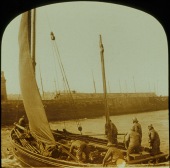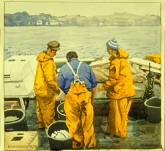Herring Home | Fishing for herring
Life Onboard

Conditions on the early open herring boats were very poor. There was no warmth or shelter and so no protection from the wet or the cold. There were only natural fibres and no waterproof fabrics for clothing. The fishermen wore heavy leather boots, which did not keep the water out. They worked hard over long hours with little sleep and they could be away from home for long periods. There was a sense of excitement, and a good catch meant plenty of money to look after the family.
Towards the end of the 19th century as boats were built bigger and with decks, they offered a little more shelter. When power began to be introduced at the end of the 19C, boat design changed and boats became still larger and were built with cabins. These offered more warmth and comfort. By the 20th century boats had closed in cabins and bunks, and there was usually a cook onboard. Man-made fabrics also began to be introduced leading to light, warm and waterproof clothing.

Boats now have all sorts of high technology onboard. There are usually also gutting shelters so that even when the fishermen are working outside they are sheltered from the elements. As fish stocks have declined, some fishermen have to travel long distances to fishing grounds and may be away from their homes and families for many days. Compared with other jobs, fishing is still very dangerous. Weather can change suddenly and fishermen may still be caught out. Accidents also continue to happen.
Herring Home | Fishing for herring